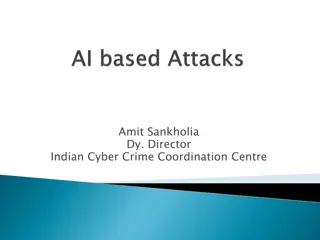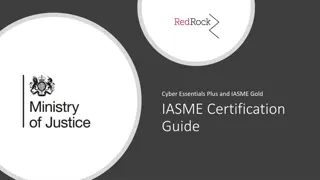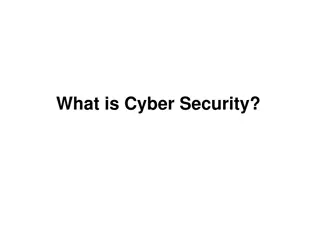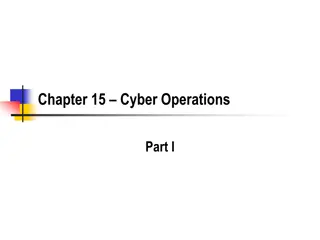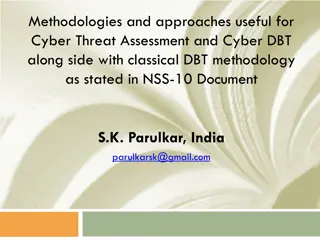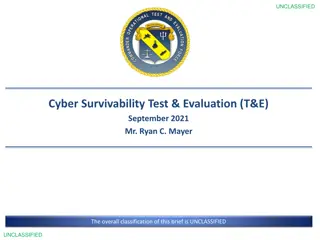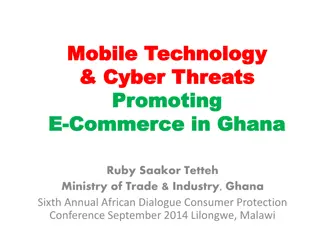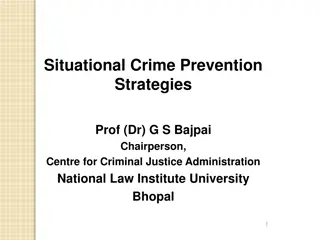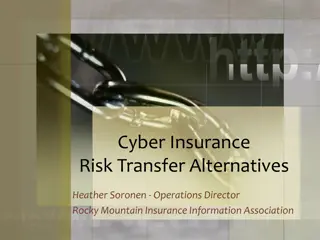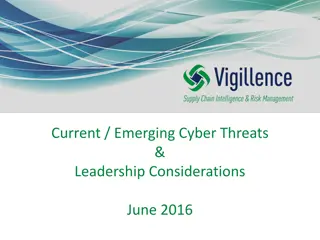Cyber Crime and Fraudulent Activities
Cyber crime encompasses various fraudulent activities, including producing counterfeit access devices, trafficking unauthorized devices, possessing illegal equipment, and engaging in unauthorized transactions. Those involved in such crimes can face severe penalties, including fines and imprisonment. It is crucial to be aware of the laws and regulations surrounding cyber crimes to prevent and combat such illicit activities.
Download Presentation

Please find below an Image/Link to download the presentation.
The content on the website is provided AS IS for your information and personal use only. It may not be sold, licensed, or shared on other websites without obtaining consent from the author.If you encounter any issues during the download, it is possible that the publisher has removed the file from their server.
You are allowed to download the files provided on this website for personal or commercial use, subject to the condition that they are used lawfully. All files are the property of their respective owners.
The content on the website is provided AS IS for your information and personal use only. It may not be sold, licensed, or shared on other websites without obtaining consent from the author.
E N D
Presentation Transcript
Cyber Crime Cyber Crime
(1) knowingly and with intent to defraud produces, uses, or traffics in one or more counterfeit access devices; (2) knowingly and with intent to defraud traffics in or uses one or more unauthorized access devices during any one-year period, and by such conduct obtains anything of value aggregating $1,000 or more during that period; (3) knowingly and with intent to defraud possesses fifteen or more devices which are counterfeit or unauthorized access devices; (4) knowingly, and with intent to defraud, produces, traffics in, has control or custody of, or possesses device-making equipment; (5) knowingly and with intent to defraud effects transactions, with 1 or more access devices issued to another person or persons, to receive payment or any other thing of value during any 1-year period the aggregate value of which is equal to or greater than $1,000; (6) without the authorization of the issuer of the access device, knowingly and with intent to defraud solicits a person for the purpose of- (A) offering an access device; or (B) selling information regarding or an application to obtain an access device; (7) knowingly and with intent to defraud uses, produces, traffics in, has control or custody of, or possesses a telecommunications instrument that has been modified or altered to obtain unauthorized use of telecommunications services; (8) knowingly and with intent to defraud uses, produces, traffics in, has control or custody of, or possesses a scanning receiver; (9) knowingly uses, produces, traffics in, has control or custody of, or possesses hardware or software, knowing it has been configured to insert or modify telecommunication identifying information associated with or contained in a telecommunications instrument so that such instrument may be used to obtain telecommunications service without authorization; or (10) without the authorization of the credit card system member or its agent, knowingly and with intent to defraud causes or arranges for another person to present to the member or its agent, for payment, 1 or more evidences or records of transactions made by an access device; shall, if the offense affects interstate or foreign commerce. (1) Whoever attempts to commit an offense under subsection (a) of this section shall be subject to the same penalties as those prescribed for the offense attempted. (2) Whoever is a party to a conspiracy of two or more persons to commit an offense under subsection (a) of this section, if any of the parties engages in any conduct in furtherance of such offense, shall be fined an amount not greater than the amount provided as the maximum fine for such offense under subsection (c) of this section or imprisoned not longer than one-half the period provided as the maximum imprisonment for such offense under subsection (c) of this section, or both.
When would you get involved? When would you get involved?
Cyber Crime 2016 Stats Cyber Crime 2016 Stats The global cost of cybercrime will reach $2 trillion by 2019, a threefold increase from the 2015 estimate of $500 billion. The cybercrime cost figure above may be the tip of the iceberg. According to The Global Risks Report 2016, from the World Economic Forum, a significant portion of cybercrime goes undetected or unreported. This is particularly true in the case of industrial espionage and the heist of proprietary secrets, because illicit access to sensitive or confidential documents and data is hard to detect. According to the Identity Theft Resource Center s (ITRC) ITRC Data Breach Report, more than 29 million records were exposed in 858 publicized breaches across sectors including financial, government, health care and education. (33,800 average) According to the Ponemon Institute s 2016 Cost of Data Breach Study: Global Analysis, which queried 383 organizations that suffered at least one breach in 2016, the average cost per breach was $4 million. That figure rose to $7 million in the U.S. The same study found that the cost per record stolen averages $158 globally, but tops $220 in the U.S. Due to the intensity of compliance and regulations, the costs per breach to organizations in the health care and financial services sectors top all other industry groups, according to the Ponemon study. The financial hit resulting from theft of trade secrets ranges from 1 percent to 3 percent of an entire nation s gross domestic product (GDP), according to IDG s Global State of Information Security Survey 2016. The cost ranges from $749 billion to $2.2 trillion annually. Last year, IDG detected 38 percent more cybersecurity incidents than the year prior. 48 percent of data security breaches are caused by acts of malicious intent. Human error or system failure account for the rest.
Small and midsized organizations (SMBs) Small and midsized organizations (SMBs) Defined as those with 100 to 1,000 employees, are hardly immune to cybercrime actually quite to the contrary. According to Keeper Security s The State of SMB Cybersecurity report, a staggering 50 percent of small and midsized organizations reported suffering at least one cyberattack in the last 12 months. The average cost of a data breach involving theft of assets totaled $879,582 for these SMBs. They spent another $955,429 to restore normal business in the wake of successful attacks. For these SMBs, 60 percent of employees use the exact same password for everything they access. Meanwhile, 63 percent of confirmed data breaches leverage a weak, default or stolen password.
Cybersecurity Spending and Resources Cybersecurity Spending and Resources Global spending to combat cybercrime will top $80 billion this year, with organizations increasingly focusing on detection and response because taking preventive approaches have not been successful in blocking malicious attacks. Spending on cyber insurance has swelled, primarily in the U.S., from $1 billion two years ago to $2.5 billion in 2016. Experts expect dramatic growth in the next five years as the insurance concept spreads globally. In 2016, 62 percent of organizations used managed security services for at least part of their cybercrime defenses, according to PwC s The Global State of Information Security report. Just half of the global organizations PwC surveyed reported that they already use advanced big data analytics to model for and identify threats. Meanwhile, machine learning techniques are adding significant muscle to fraud detection and application security efforts.
Preparedness and Response Preparedness and Response Only 38 percentof organizations surveyed for ISACA s 2015 Global Cybersecurity Status Report believed they were prepared to meet the onslaught of sophisticated cybercrime. Of the 1,000 IT leaders polled for Invincea s 2016 Cyberthreat Defense Report, three-quarters reported that their networks had been breached in the last year, and 62 percent said they expect to suffer a successful cyberattack at some point this year. Phishing is a well-known cybercrime technique that involves defrauding an online account user by posing as a legitimate entity. According to the Verizon DBIR, 30 percent of phishing emails are actually opened, and 12 percent of those targeted click on the infecting link or attachment. An Osterman Research survey of 540 organizations in North America, the U.K. and Germany revealed that nearly half had sustained ransomware attacks in the last year.


